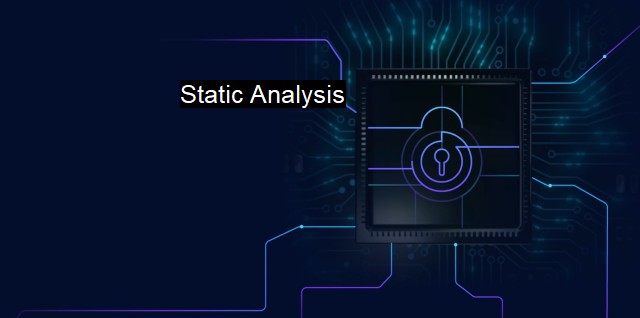What are Static Analysis?
Strengthening Cybersecurity Measures with Static Analysis: An Insight into Static Code Analysis (SCA) for Software Applications
Static analysis, in the context of cybersecurity and antivirus software, is a method of examining software for potential vulnerabilities without having to execute or run the software. Static analysis, also referred to as "static code analysis" or "code inspection", involves reviewing the software's structure, properties, and source code to pinpoint possible security issues, bugs, or programming errors. The primary objective is to improve system security by identifying potential weaknesses that could be exploited by hackers.This cybersecurity approach is distinctively different from other techniques such as dynamic analysis. Dynamic analysis involves examining software while it's in operation, whereas static analysis can expose vulnerabilities dormant within the code regardless of whether they act out during regular software execution. In static analysis, the code under review does not perform any actions; instead, its logic, format, and security regulations are inspected to draw conclusions about potential areas of concern.
When launching a Static Analysis Security Testing (SAST), a significant point out is that it must encompass not only the inspection of application source code but also of the binary code and machine code. It prevents any malicious addition to the code during the build process and executes a thorough checking for any vulnerabilities, bugs or issues with regulatory compliance.
Static analysis depends upon a suite of techniques to detect flaws. It includes control flow checking, which examines the program's execution path and proper operating of loops and conditionals; it also encompasses data flow checking, a form of analysis that reviews how variables in the code change and track their values over time. it involves lexical and syntactic checking to ensure code falls within set language constructs.
Static analysis helps identify issues like buffer overflows, memory leaks, null pointer dereferencing, and unused variables - all common sources of software vulnerabilities. Also, it predicts unpredictable or undefined behavior that could stand out as a problematic area after deployment.
In antivirus and malware detection, static analysis has profound importance. It scans unfamiliar files using a predefined signature database, a set of recognizable binary patterns that align with known harmful software characteristics. Though heuristic approaches have grown in modern antivirus solutions to look for suspicious patterns beyond recognized ones, static analysis plays a key role in offering a strong line of defense against known threats.
Static analysis offers numerous benefits. Considering cyber threats, prevention is always a preferable and cost-efficient strategy than damage control. By detecting flaws early in the development process, static analysis significantly reduces security risks and enhances the process of resolution through debugging.
Static analysis is not void of limitations. It can generate false-positive results, identifying pieces of code as potential risks, although they are not. This instance demands additional discernment to sift out actual threats from misleading alerts. Despite its constraints, the value of static analysis in secure software development and antivirus solution is undeniable.
Static analysis is an invaluable tool in the ever-evolving landscape of cybersecurity and antivirus software. Through early detection and resolution of system flaws, it greatly decreases the possibilities of cyber threats, enforcing a stronger and more efficient system security that beneficially serves both the end-users and developers.

Static Analysis FAQs
What is static analysis in cybersecurity?
Static analysis is a technique used in cybersecurity to identify vulnerabilities and security weaknesses in software code without actually executing the code. It involves analyzing the code's syntax and structure to identify potential security risks. This technique is commonly used in antivirus software to detect malware before it has a chance to execute on a system.How does static analysis differ from dynamic analysis in cybersecurity?
Static analysis is performed on the source code or binary executable of an application without actually executing it, while dynamic analysis is performed by running the application and monitoring its behavior in real-time. Static analysis can identify potential vulnerabilities and weaknesses in an application before it is even deployed, while dynamic analysis can identify actual exploits and attacks that are occurring while the application is running.Can static analysis guarantee that an application is free of vulnerabilities?
No, static analysis cannot guarantee that an application is free of vulnerabilities. It can only identify potential security weaknesses based on the analysis of the code. There may be vulnerabilities that cannot be detected through static analysis or that are introduced after the analysis has been performed. It is important to use multiple approaches to security testing, including dynamic analysis and manual code reviews, to ensure the highest level of security for an application.How can static analysis be integrated into an organization's cybersecurity program?
Static analysis can be integrated into an organization's cybersecurity program by incorporating it into the software development lifecycle. This can include using automated tools to run static analysis on code before it is committed to a repository or deployed to production. It can also involve training developers on secure coding practices and using static analysis as a way to identify areas where additional training or support may be needed. Additionally, organizations can use third-party static analysis services as part of their ongoing security testing and vulnerability management programs.| | A | | | B | | | C | | | D | | | E | | | F | | | G | | | H | | | I | | | J | | | K | | | L | | | M | |
| | N | | | O | | | P | | | Q | | | R | | | S | | | T | | | U | | | V | | | W | | | X | | | Y | | | Z | |
| | 1 | | | 2 | | | 3 | | | 4 | | | 7 | | | 8 | | |||||||